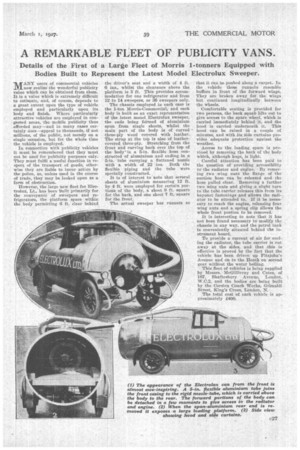A REMARKABLE FLEET OF PUBLICITY VANS.
Page 49

If you've noticed an error in this article please click here to report it so we can fix it.
Details of the First of a Large Fleet of Morris 1-tonners Equipped with Bodies Built to Represent the Latest Model Electrolux Sweeper.
MANY users of commercial vehicles now realize the wonderful publicity value which can be obtained from them. It is a value which is extremely difficult to estimate, and, of course, depends to a great extent upon the type of vehicle employed and particularly upon its body and finish. Where particularly attractive vehicles are employed in congested areas, the mobile publicity thus afforded may—and in many cases certainly does—appeal to thousands, if not millions, of the public, not merely on a single occasion, but for the whole time the vehicle is employed.
In connection with publicity vehicles it must be remembered that they must not be used for publicity purposes only. They must fulfil a useful function in respect of the transport of goods, otherwise they are liable to incur action by the police, as, unless used in the course of trade, they may be looked upon as a form of obstruction.
However, the large new fleet for EketroluX, Lt., has been built primarily for the conveyance of sweepers and refrigerators, the platform space within the body permitting 6 ft. clear behind
the driver's seat and a width of 4 ft. 6 ins., whilst the clearance above the platform is 3 ft. This provides accommodation for one refrigerator and from 12 to 14 sweepers, or 36 sweepers only.
The chassis employed in each case is the 1-ton Morris-Commercial, and each body is built as an exact representation of the latest model Electrolux sweeper, the ends being formed of aluminium spun from single sheets, whilst the main part of the body is of curved three-ply wood covered with leather. The strap at the top is also of leathercovered three-ply. Stretching from the front and curving back over the top of the body'is a 5-in. flexible hose constructed of aluminium and ending in a 5-in. tube carrying a flattened nozzle with a width of 22 ins. Both the flexible piping and the tube were specially constructed.
It is of interest to note that several sheets of aluminium measuring 12 It. by 4 ft. were employed for certain portions of the body, a sheet 9 ft. square for the back, and one sheet 7 ft. square for the front.
The actual sweeper has runners so that it can be pushed along a carpet. In the vehicle these runners resemble buffers in front of the forward wings. They are broken away for the wings but continued longitudinally between the wheels.
Comfortable seatins' is provided for two persons, the back squab lifts out to give access to the spare wheel, which is carried immediately behind it, and the hood is carried underneath it. This hood can be raised in a couple of minutes, and with its side curtains provides adequate protection against the weather.
Access to the loading space is provided by removing the back of the body which, although huge, is light.
Careful attention has been paid to the question of providing accessibility to the radiator and engine. By removing two wing nuts the flange of the suction hose can be released and thehose pulled .clear. Removing a further two wing nuts and giving a slight turn to the tube carrier releases this from its bayonet fastenings and allows the radiator to be attended to. If it be necessary to reach the engine, releasing four wing nuts and a spring clip allows the whole front portion to be removed.
It is interesting •to note that it has not been found necessary to modify the chassis in any way, and the petrol tank is conveniently situated behind the instrument board.
To provide a current of air for cooling the radiator, the tube carrier is cut away at the sides, and that this is effective is proved by the fact that the vehicle has been driven up Fitzjohn's Avenue and on to the Heath on second gear without the water boiling. • This fleet of vehicles is being supplied by Messrs. McGillivray and Cates, of 167, Shaftesbury Avenue, London, W.C2, and the bodies are being built by the Corsica Coach Works, Grimaldi Street, King's Cross, London, N.
The total cost of each vehicle is approximately £400.












































































































